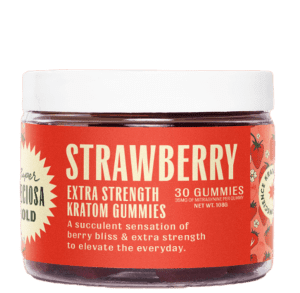Kratom is an herbal substance used for its potential medicinal benefits. This tropical tree native to Southeast Asia has been traditionally consumed to produce both stimulating and sedative effects.
For many, kratom is believed to have the potential to manage pain, depression, anxiety, and even opioid withdrawals. It’s also considered to have therapeutic benefits like calming properties, and mood-boosting effects.
In this blog post, we’ll discuss what makes kratom unique along with a guide on how to use it safely.
What is Kratom? Overview of Kratom

Derived from kratom leaves of the kratom tree, kratom has long been used for its medicinal properties.
When ingested, kratom interacts with opioid receptors in the brain to produce psychoactive effects.
At low doses, kratom can act as a stimulant, giving users heightened alertness and energy levels. At high doses, it can have soothing properties that reduce pain and anxiety while producing feelings of euphoria and relaxation.
The active chemicals found in kratom leaves are thought to be responsible for the dual nature of its effects. For example, mitragynine binds to mu-opioid receptors to cause relaxation or sedation. On the other hand, 7-hydroxymitragynine acts mainly on delta opioid receptors to create an energizing feeling or stimulating effect.

Super Speciosa
Rating: 4.9
- 35mg Mitragynine/Gummy
- Natural Ingredients
- Lab Tested Quality
- Safety Evaluated
Common Uses of Kratom
Kratom users take it for its variety of potential effects, such as pain relief, mood enhancement, and energy boosts.
It is commonly believed to act on opioid receptors in the brain, providing users with stimulant effects at lower doses and sedative-like effects at higher doses.
With this potential range of effects, users have begun exploring kratom as a natural treatment for pain relief, management of depression and anxiety symptoms, or even as an aid during opioid withdrawal.
There are many different strains and types of kratom available that differ in their potency levels so it’s important to find the right strain that works best for individual health goals.
Safety considerations
When considering kratom use, it’s important to be aware of the potential risks. Kratom has been found to cause a variety of side effects including nausea, vomiting, constipation, itching, irritability, and agitation.
Additionally, depending on various factors, long-term use can lead to increased tolerance for the drug which could result in an addiction or dependence.
In some cases, users may experience withdrawal symptoms such as sweating or chills when stopping usage abruptly. Therefore it is recommended that anyone using kratom do so responsibly by following dosing guidelines and seeking professional medical help if any physical or psychological dependence occurs.
Medical Potential of Kratom

Recent scientific research has revealed potential medical uses of kratom, such as treating chronic pain and reducing opioid withdrawal symptoms.
Possible uses of kratom as medicine
Research suggests that compounds in kratom bind to opioid receptors in the brain. This influences emotions and mood like an opioid drug would. This could be why some people report feeling better after using it.
Current research and limitations
Kratom is actively being researched by scientists around the world, but there remain gaps in our knowledge.
However, more research needs to be done to determine how effective — and safe — it is when taken chronically or at high doses. Additionally, due to legal restrictions on its availability and lack of federal oversight on kratom production standards, researchers also do not yet know what contaminants may be present in commercially available kratom products and their potential effects on people who use them long-term.

Super Speciosa
Rating: 4.9
- 35mg Mitragynine/Gummy
- Natural Ingredients
- Lab Tested Quality
- Safety Evaluated
FAQs
1. What is kratom?
Kratom is a natural herb derived from the leaves of trees found in Southeast Asia. It can have sedative, stimulant, and pain-relieving properties. It has also been used for opioid withdrawal symptoms for those suffering from opioid addiction.
2. How does kratom work?
Kratom contains compounds called alkaloids that bind to opioid receptors in the brain and produce various effects. These effects are based on dose size and strain.
3 Is kratom legal?
The legality of kratom varies by country and state. Currently, it’s banned in some regions but legal for use in others with certain regulations or restrictions in place.
4 Is kratom safe?
Taking too much kratom may cause side effects such as nausea, vomiting, drowsiness, dry mouth, loss of appetite, constipation, increased urination frequency, headaches, or blurred vision. Overdoses are possible if taken with other substances such as alcohol or opioids. It’s important to use caution when consuming kratom products.






